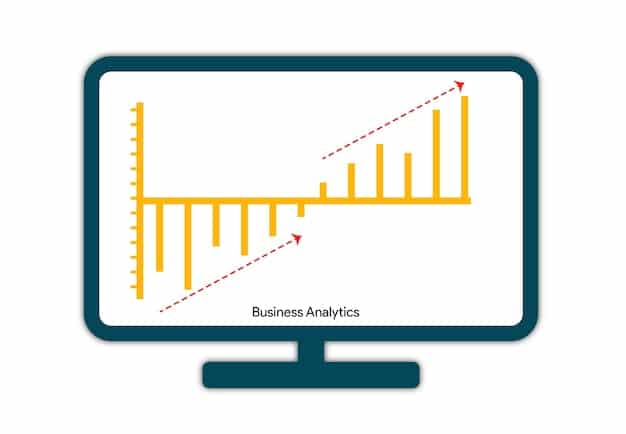E-commerce Platform Performance: Optimize Your Site Speed and Reduce Bounce Rate by 25%

E-commerce Platform Performance: Optimize Your Site Speed and Reduce Bounce Rate by 25% by implementing strategies to improve site speed, enhance user experience, and streamline the checkout process, leading to increased conversion rates and customer satisfaction.
In today’s competitive online market, e-commerce platform performance: optimize your site speed and reduce bounce rate by 25% is not just a recommendation—it’s a necessity. Slow loading times and clunky interfaces can drive potential customers away, leading to lost sales and diminished brand reputation. But how can you effectively tackle these challenges and create a seamless shopping experience that keeps visitors engaged and converting?
This article delves into proven strategies to enhance your e-commerce platform’s performance, focusing on optimizing site speed and minimizing bounce rates. By implementing these techniques, you can significantly improve user satisfaction and drive revenue growth. Let’s explore the steps to make your online store a high-performing, customer-friendly destination.
Understanding the Impact of E-commerce Platform Performance
The performance of your e-commerce platform has a direct impact on key metrics such as conversion rates, customer satisfaction, and search engine rankings. A slow website can frustrate users, leading them to abandon their shopping carts and seek alternatives. Conversely, a fast, responsive site enhances the user experience, encouraging them to make purchases and return for future transactions.
Why Site Speed Matters
Site speed is a critical factor in determining the success of an e-commerce platform. Studies have shown that even a one-second delay in page load time can result in a significant drop in conversion rates. Users expect websites to load quickly and efficiently, and if your site fails to meet these expectations, they are likely to leave.
- Improved User Experience: Faster loading times create a smoother, more enjoyable shopping experience.
- Increased Conversion Rates: A quicker site encourages users to browse more products and complete their purchases.
- Better Search Engine Rankings: Search engines like Google consider site speed as a ranking factor, giving faster sites an advantage.
E-commerce Platform Performance: Optimize Your Site Speed and Reduce Bounce Rate by 25% can be achieved through various strategies, including optimizing images, leveraging browser caching, and minimizing HTTP requests. These efforts not only improve the user experience but also boost your site’s visibility in search results.

Focusing on these elements ensures that your e-commerce platform not only meets but exceeds customer expectations, driving growth and enhancing your brand’s reputation.
Analyzing Your Current E-commerce Platform Performance
Before you can improve your e-commerce platform performance, it’s essential to assess its current state. This involves identifying key performance indicators (KPIs) and using various tools to measure site speed, bounce rate, and other relevant metrics. Understanding where your site stands now will help you prioritize optimization efforts effectively.
Key Performance Indicators (KPIs) to Monitor
Monitoring KPIs provides valuable insights into your e-commerce platform’s health. These metrics can help you identify areas of strength and weakness, allowing you to make data-driven decisions to improve overall performance.
- Page Load Time: The time it takes for a page to fully load.
- Bounce Rate: The percentage of visitors who leave your site after viewing only one page.
- Conversion Rate: The percentage of visitors who complete a purchase.
- Average Session Duration: The average amount of time visitors spend on your site during a session.
Regularly tracking these KPIs will enable you to optimize e-commerce platform performance: optimize your site speed and reduce bounce rate by 25%. By setting benchmarks and monitoring progress, you can ensure that your optimization efforts are yielding the desired results.
By focusing on these metrics, you can proactively address issues and drive continuous improvement, ultimately enhancing the shopping experience for your customers.
Optimizing Images for Faster Loading Times
Images often constitute a significant portion of a webpage’s size, making image optimization a crucial step in enhancing e-commerce platform performance. Large, unoptimized images can slow down loading times, leading to a poor user experience and higher bounce rates. By compressing images and using appropriate file formats, you can significantly improve site speed.
Best Practices for Image Optimization
Implementing best practices for image optimization can drastically reduce file sizes without sacrificing visual quality. This not only accelerates loading times but also improves the overall user experience on your e-commerce platform.
- Compress Images: Use tools like TinyPNG or ImageOptim to reduce file sizes.
- Choose the Right File Format: Use JPEG for photographs and PNG for graphics with transparency.
- Resize Images: Ensure images are appropriately sized for their display dimensions.
E-commerce Platform Performance: Optimize Your Site Speed and Reduce Bounce Rate by 25% requires careful attention to image optimization. By following these guidelines, you can minimize the impact of images on your site’s loading times and improve overall performance.

By integrating these practices into your workflow, you can maintain high-quality visuals while ensuring fast loading times and an enhanced user experience.
Leveraging Browser Caching to Reduce Server Load
Browser caching is a powerful technique that allows web browsers to store static assets such as images, stylesheets, and scripts locally. When a user revisits your e-commerce platform, the browser can retrieve these assets from its cache instead of downloading them from the server again. This significantly reduces server load and accelerates page loading times.
Implementing Browser Caching Effectively
Configuring browser caching correctly is essential for maximizing its benefits. This involves setting appropriate cache control headers and ensuring that static assets are properly cached.
- Set Cache Control Headers: Use the
Cache-Controlheader to specify how long browsers should cache assets. - Leverage a Content Delivery Network (CDN): CDNs store cached assets on multiple servers, reducing latency for users around the world.
- Use Long Cache Expiration Times: For static assets that rarely change, set long expiration times to maximize cache hits.
By implementing these strategies, you can optimize e-commerce platform performance: optimize your site speed and reduce bounce rate by 25%. Browser caching not only improves site speed but also reduces the strain on your server, leading to a more stable and responsive e-commerce platform.
Effective implementation requires a comprehensive understanding of cache control mechanisms, but the benefits are well worth the effort in terms of improved performance and user experience.
Minimizing HTTP Requests for Faster Page Rendering
Each element on a webpage, such as images, stylesheets, and scripts, requires an HTTP request to be downloaded from the server. Reducing the number of HTTP requests can significantly improve page loading times, especially for users with slower internet connections. Minimizing HTTP requests is a key strategy for enhancing e-commerce platform performance.
Techniques to Reduce HTTP Requests
Several techniques can be employed to reduce the number of HTTP requests required to render a webpage. These include combining files, using CSS sprites, and inlining critical CSS.
- Combine CSS and JavaScript Files: Reduce the number of files by merging them into fewer, larger files.
- Use CSS Sprites: Combine multiple small images into a single image file and use CSS to display the appropriate portions.
- Inline Critical CSS: Include the CSS necessary for rendering the above-the-fold content directly in the HTML to avoid render-blocking.
Implementing these techniques will help you optimize e-commerce platform performance: optimize your site speed and reduce bounce rate by 25%. By minimizing HTTP requests, you can streamline the loading process and provide a faster, more responsive experience for your users.
These strategies require a systematic approach, but their impact on site speed and user experience makes them essential for any e-commerce platform.
Optimizing Your E-commerce Platform for Mobile Devices
With the majority of online traffic now coming from mobile devices, optimizing your e-commerce platform for mobile is crucial. A mobile-friendly site not only provides a better user experience but also ranks higher in mobile search results. Ensuring your e-commerce platform is responsive and fast on mobile devices is essential for success.
Strategies for Mobile Optimization
Several strategies can be employed to optimize your e-commerce platform for mobile devices. These include using a responsive design, optimizing images for mobile, and leveraging browser caching.
- Use a Responsive Design: Ensure your site adapts seamlessly to different screen sizes and resolutions.
- Optimize Images for Mobile: Use smaller, compressed images for mobile devices.
- Leverage Browser Caching: Reduce loading times by caching static assets on mobile devices.
By implementing these strategies, you can optimize e-commerce platform performance: optimize your site speed and reduce bounce rate by 25% for mobile users. A mobile-friendly e-commerce platform will attract more visitors, improve conversion rates, and enhance customer satisfaction.
Mobile optimization requires a comprehensive approach, but its importance in today’s mobile-first world cannot be overstated. By prioritizing mobile, you can ensure that your e-commerce platform remains competitive and successful.
| Key Point | Brief Description |
|---|---|
| 🚀 Site Speed Optimization | Reduce page load times to enhance user experience and SEO. |
| 🖼️ Image Optimization | Compress and resize images to decrease file sizes. |
| ⏱️ Browser Caching | Leverage caching to reduce server load and improve speed. |
| 📱 Mobile Optimization | Ensure your site is responsive and fast on mobile devices. |
Frequently Asked Questions
Optimizing your e-commerce platform performance enhances user experience, reduces bounce rates, and improves conversion rates. Fast loading times and seamless navigation are crucial for customer satisfaction and business success.
You can use tools like Google PageSpeed Insights, GTmetrix, and WebPageTest to measure your e-commerce platform’s speed. These tools provide detailed insights into your site’s performance and offer recommendations for improvement.
Effective image optimization includes compressing images, choosing the right file format (JPEG for photos, PNG for graphics), and resizing images to fit their display dimensions. Using tools like TinyPNG or ImageOptim can help.
Browser caching allows browsers to store static assets locally, reducing the need to download them from the server on subsequent visits. This speeds up page loading times and reduces server load, enhancing performance.
Mobile optimization is crucial because a significant portion of online traffic comes from mobile devices. A mobile-friendly site provides a better user experience, ranks higher in search results, and improves conversion rates.
Conclusion
In conclusion, e-commerce platform performance: optimize your site speed and reduce bounce rate by 25% is essential for maintaining a competitive edge in the online marketplace. By following the strategies outlined in this article, you can significantly enhance user experience, improve conversion rates, and boost your bottom line.
Prioritizing site speed, optimizing images, leveraging browser caching, and ensuring mobile-friendliness, are all vital steps. Embrace these practices, and watch your e-commerce platform thrive.





